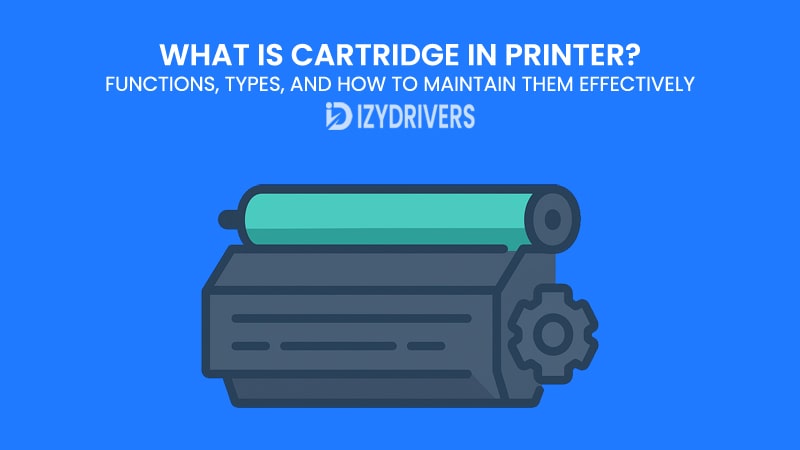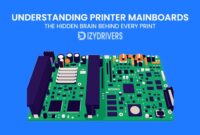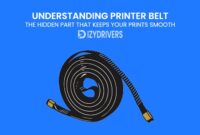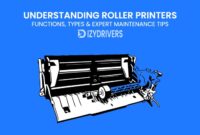When talking about printing quality and efficiency, one component often comes into focus: the cartridge in printer. This small yet essential printer parts determines not only the clarity of your documents but also the overall cost of printing in the long run. Many printer users replace cartridges regularly without truly understanding their functions, types, or how to maintain them properly.
Knowing what a cartridge in printer does—and how to care for it—can save you money, improve print quality, and extend the life of your printer. Whether you own a home printer for occasional tasks or a business printer for heavy workloads, understanding cartridges helps you make better purchasing and maintenance decisions.
In this guide, we’ll break down what a cartridge in printer actually is, its key functions, different types available, common problems, and the best practices to keep it working effectively for longer periods.
What is a Printer Cartridge?
A cartridge in printer is the component responsible for holding and delivering ink or toner to the paper during the printing process. Without it, even the most advanced printer cannot produce a single page. Essentially, it acts as the “ink reservoir” and is directly linked to print quality, cost, and efficiency.
Inside a standard cartridge in printer, you will typically find several key components:
- Ink or Toner Chamber: This is where the actual printing material is stored. Ink cartridges use liquid ink, while toner cartridges store fine powder for laser printing.
- Nozzle Plate or Printhead: A precision mechanism that sprays or transfers ink onto the paper in exact patterns to create text and images.
- Smart Chip or Electronic Contacts: These parts allow the cartridge to communicate with the printer, reporting ink levels and ensuring compatibility.
Cartridges come in various designs depending on the printer type. For example, some inkjet printers use a single cartridge in printer for black ink and another for color, while others have separate cartridges for each color. Laser printers, on the other hand, use toner cartridges specifically designed for high-speed, high-volume printing.
The quality of the cartridge in printer directly affects the sharpness, color accuracy, and durability of your prints. Choosing the right cartridge type—and understanding its role—can save you from unnecessary replacements and ensure consistent printing performance.
Functions of a Printer Cartridge
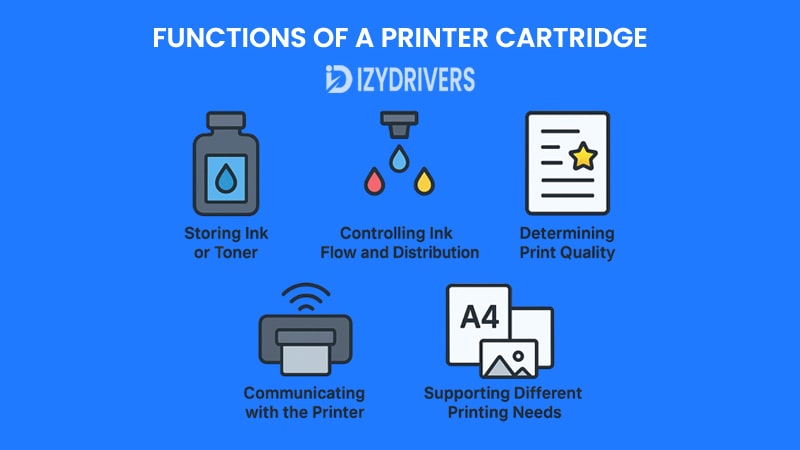
The cartridge in printer serves as the core element that transforms digital files into physical prints. Its role goes far beyond simply storing ink or toner; it actively controls how text and images appear on paper, influencing everything from print resolution to color accuracy. Understanding each function in detail helps users choose the right cartridge, troubleshoot issues effectively, and maintain overall print quality over time.
Below are the key functions of a cartridge in printer, explained in depth:
1. Storing Ink or Toner
At its most basic level, the cartridge in printer acts as a secure storage unit for the printing material—liquid ink in inkjet printers or powdered toner in laser printers. The quality, formulation, and quantity of this ink or toner directly affect the final output on paper. High-capacity cartridges, for example, can store more material, enabling longer use without frequent replacements.
In addition, the storage design inside the cartridge in printer prevents ink drying and toner clumping when the printer is idle. Some cartridges even incorporate smart sealing mechanisms to keep the contents fresh, ensuring consistent performance even after long periods of non-use.
2. Controlling Ink Flow and Distribution
One of the most critical functions of the cartridge in printer is regulating the precise amount of ink or toner applied to the paper. In inkjet printers, microscopic nozzles spray ink droplets at exact locations, while in laser printers, a complex process involving lasers and electrostatic charges ensures toner particles adhere only to designated areas.
This level of control helps prevent common printing issues such as smudging, bleeding, or uneven color distribution. By managing ink flow accurately, the cartridge in printer ensures crisp text, vibrant images, and professional-quality prints across multiple print jobs.
3. Determining Print Quality
Print resolution, color vibrancy, and overall sharpness depend heavily on the quality and technology behind the cartridge in printer. High-end cartridges with advanced printhead designs can deliver resolutions of 1200 dpi or more, producing images with smoother gradients and sharper details.
Moreover, the type of ink or toner formula used in the cartridge in printer plays a major role. Pigment-based inks, for example, are known for their durability and water resistance, while dye-based inks produce more vivid colors, making them ideal for photo printing.
4. Communicating with the Printer
Modern cartridge in printer models often come equipped with chips or sensors that facilitate two-way communication with the printer. These smart components track ink or toner levels, usage patterns, and even potential errors, sending real-time updates to the printer’s control panel or connected devices.
This communication reduces downtime by alerting users before the cartridge runs out or if a malfunction occurs. It also helps printers optimize performance, automatically adjusting settings based on the type of printer cartridge installed.
5. Supporting Different Printing Needs
The cartridge in printer is versatile enough to handle various printing demands, from simple text documents to high-resolution photos and large-scale business reports. Specialized cartridges, such as photo cartridges or high-yield cartridges, are designed to meet specific requirements without compromising quality or efficiency.
For businesses that handle bulk printing, high-capacity toner cartridges offer lower cost-per-page ratios, while individuals printing creative projects might prefer cartridges optimized for vibrant colors and finer details. This adaptability makes the cartridge in printer an essential component for both casual and professional users.
Types of Printer Cartridges
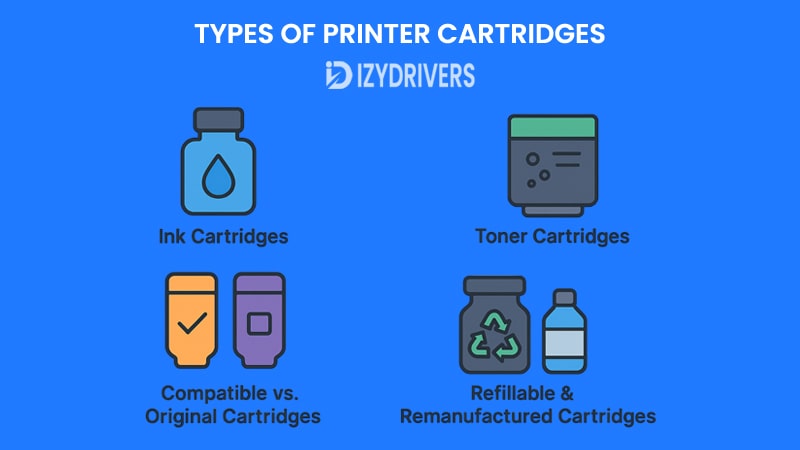
Not all cartridges are created equal. The type of cartridge in printer you choose can directly impact cost, print quality, and maintenance frequency. Understanding the differences helps you pick the right cartridge for your printing needs.
Ink Cartridges
Ink cartridges are commonly used in inkjet printers. They contain liquid ink and are ideal for producing high-quality images, colorful graphics, and professional documents. Some inkjet printers use one cartridge in printer for all colors, while others have individual cartridges for cyan, magenta, yellow, and black inks.
Pros:
- Excellent print quality for photos and graphics
- Compact and easy to replace
Cons:
- Ink dries out if unused for long periods
- Higher cost per page compared to toner cartridges
Toner Cartridges
Toner cartridges are used in laser printers and store fine powder instead of liquid ink. They are best for high-speed, high-volume printing environments. A cartridge in printer with toner usually lasts longer than ink cartridges, making them cost-effective for offices.
Pros:
- Fast printing speeds
- Lower cost per page over time
- High durability and longer shelf life
Cons:
- Higher initial cost
- Bulky design compared to ink cartridges
Compatible vs. Original Cartridges
An original cartridge in printer (OEM) is manufactured by the same company as the printer, while compatible cartridges are produced by third-party companies. Compatible cartridges are usually cheaper but may have slight differences in quality or compatibility.
Refillable & Remanufactured Cartridges
- Refillable cartridges can be manually refilled with ink multiple times, reducing long-term costs.
- Remanufactured cartridges are recycled OEM cartridges cleaned, refilled, and tested for reuse.
Both options are eco-friendly and help reduce printing expenses, though print quality may vary depending on the refill materials used.
Comparison Types of Printer Cartridges and Their Key Features
| Cartridge Type | Printing Technology | Print Quality | Cost Efficiency | Best Use Case | Pros | Cons |
|---|---|---|---|---|---|---|
| Ink Cartridges | Inkjet | High (Photos & Graphics) | Moderate | Home printing, photo printing | Vibrant colors, precise details | Ink dries if unused, higher cost per page |
| Toner Cartridges | Laser | High (Text & Documents) | High | Office, bulk printing | Fast printing, long-lasting | Higher initial cost |
| OEM Cartridges | Inkjet/Laser | Consistent | Moderate | Professional printing | Manufacturer-approved quality | Expensive |
| Compatible Cartridges | Inkjet/Laser | Variable | High | Budget printing | Cheaper than OEM | Quality may vary |
| Refillable Cartridges | Inkjet | Variable | Very High | Eco-friendly, cost-saving printing | Reusable, lower long-term cost | Potential mess during refill |
| Remanufactured Cartridges | Inkjet/Laser | Moderate to High | High | Budget & eco-conscious users | Recycled, environmentally friendly | Quality depends on refurbishing process |
How Printer Cartridges Work
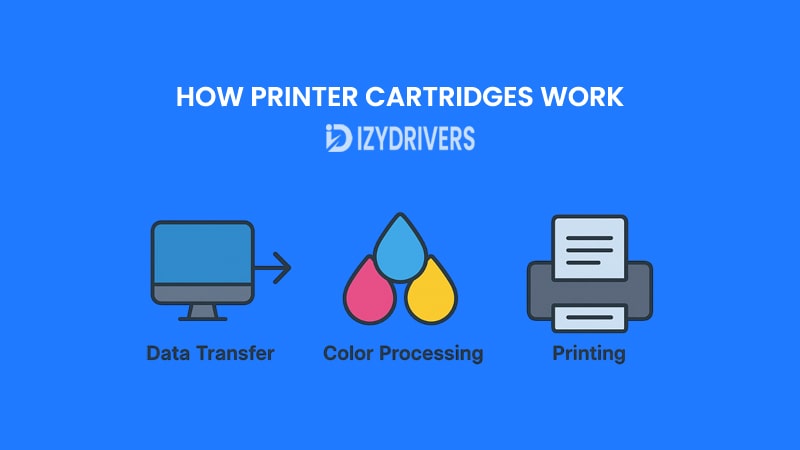
The cartridge in printer operates through a series of coordinated steps that transform digital data into printed text and images on paper. Understanding this process helps users troubleshoot problems, maintain print quality, and optimize cartridge performance.
Data Transfer
The process begins when the computer or device sends a print command to the printer. This command contains all the necessary information about the document, including text, images, layout, and colors.
The printer driver converts this data into a format the printer can understand and transfers it to the cartridge in printer, preparing it for the printing process.
Color Processing
Once the data reaches the printer, the cartridge in printer plays a critical role in color processing. For inkjet cartridges, the printhead mixes different ink colors—cyan, magenta, yellow, and black—to produce the correct shades and tones.
For toner cartridges, the printer uses lasers and electrical charges to transfer toner particles onto the drum, which then forms the desired image or text.
Printing
In the final step, the cartridge in printer delivers ink or toner onto the paper with precision. In inkjet printers, tiny nozzles spray ink droplets in exact patterns, while in laser printers, the toner particles are fused onto the paper using heat and pressure.
The result is a sharp, durable print that matches the digital original as closely as possible.
Workflow Table: How a Cartridge in Printer Works Step by Step
| Process Stage | Description | Technology Involved | Output Generated |
|---|---|---|---|
| Data Transfer | Computer sends print command; printer driver converts digital file into printer-readable format. | Printer Driver, Printer Firmware | Printable data ready for processing |
| Color Processing | Cartridge processes color data; inkjet mixes CMYK inks, while laser printers use lasers & electric charges on drum. | Printhead (Inkjet), Laser & Drum Unit | Color or monochrome image/text pattern on drum |
| Printing | Cartridge delivers ink or toner precisely onto paper; inkjet sprays droplets, laser fuses toner with heat & pressure. | Nozzles (Inkjet), Fuser Unit (Laser) | Final printed page with sharp text and images |
Common Problems and Troubleshooting Tips
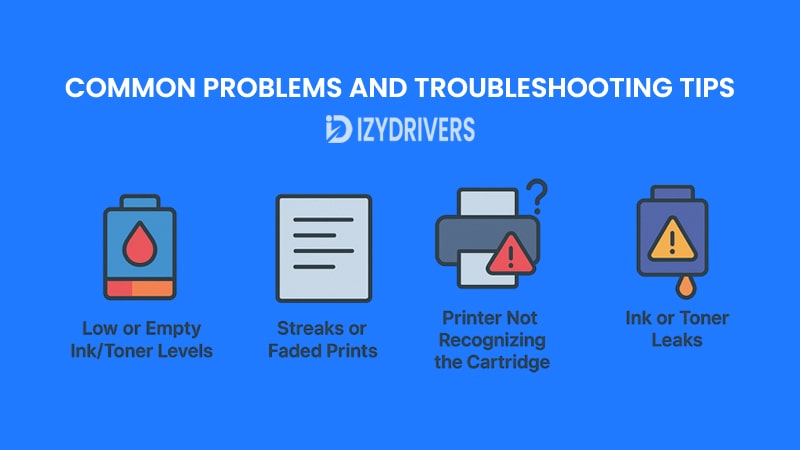
Even the best cartridge in printer can experience issues over time. Understanding the most common problems and how to fix them can save time, money, and frustration. Below are typical cartridge-related issues along with practical troubleshooting tips:
Low or Empty Ink/Toner Levels
Problem: The printer displays a “low ink” or “empty cartridge” warning even though the cartridge in printer seems new or recently replaced.
Troubleshooting Tips:
- Remove the cartridge, gently shake it to redistribute the ink or toner, then reinstall it.
- Check for protective seals or packaging materials that were not removed.
- If the warning persists, reset the printer’s ink/toner counter via the control panel or software.
Streaks or Faded Prints
Problem: Printouts have streaks, faded sections, or missing colors, which often indicate clogged nozzles or uneven toner distribution.
Troubleshooting Tips:
- Run the printer’s built-in printhead cleaning cycle for inkjet printers.
- For toner cartridges, gently shake the cartridge in printer to spread the toner evenly.
- Check that the paper type matches printer settings to avoid poor ink absorption.
Printer Not Recognizing the Cartridge
Problem: The printer refuses to print because it doesn’t recognize the cartridge in printer, even if it is compatible.
Troubleshooting Tips:
- Remove the cartridge and wipe the electronic contacts with a lint-free cloth.
- Update the printer’s firmware to ensure compatibility with third-party cartridges.
- Power cycle the printer to reset its detection system.
Ink or Toner Leaks
Problem: Cartridges may leak ink or toner inside the printer, causing messy printouts or internal damage.
Troubleshooting Tips:
- Handle cartridges carefully and avoid overfilling refillable cartridges.
- Clean any spills immediately using printer-safe cleaning materials.
- Replace leaking cartridges to prevent long-term damage.
Maintenance Tips for Longer Cartridge Life
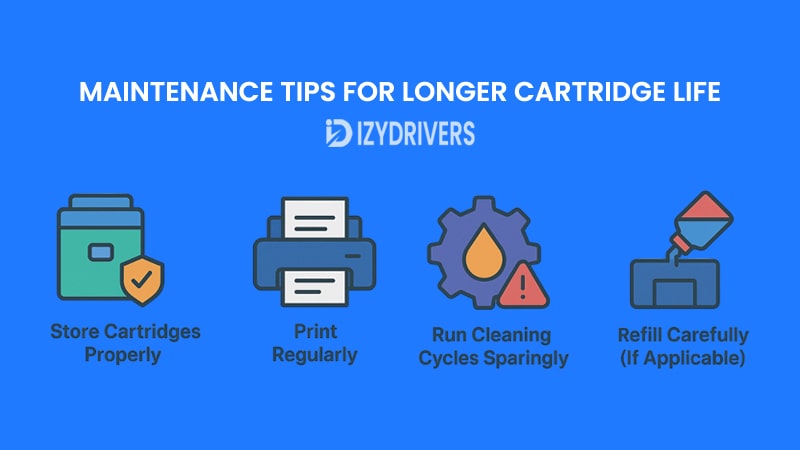
Proper care of your cartridge in printer not only saves money but also ensures consistent print quality and reduces unexpected problems. Many users overlook simple maintenance steps that can significantly extend the life of their cartridges. Below are essential tips explained in greater detail:
Store Cartridges Properly
When not in use, keep your cartridge in printer in a cool, dry place away from direct sunlight or excessive heat. High temperatures can cause toner powder to clump together or ink to dry out inside the cartridge, making it unusable even before it reaches the printer. Ideally, cartridges should be stored at room temperature in their original packaging, which is designed to prevent dust and moisture from entering.
If you need to store an open cartridge, consider sealing it in an airtight plastic bag with a slightly damp cloth (not touching the cartridge) to maintain humidity levels. This prevents ink from drying inside the nozzles while keeping the cartridge safe from environmental damage. For toner cartridges, keeping them upright helps prevent uneven toner distribution, which can cause print defects when reused.
Print Regularly
One of the simplest ways to maintain a cartridge in printer is to print regularly. When a printer sits idle for weeks, the ink inside the nozzles can dry out, causing clogs that lead to streaky or faded prints. Printing a small test page once or twice a week ensures the ink continues to flow properly, keeping the nozzles clear and the internal components in good working condition.
Laser printer users also benefit from periodic use because toner can sometimes settle unevenly inside the cartridge if left unused for a long time. A quick print cycle redistributes the toner evenly, reducing the risk of print quality issues later on.
Use High-Quality Paper
The type of paper you use affects not only the final print quality but also the lifespan of the cartridge in printer. Low-quality or incompatible paper can absorb too much ink, causing smudges, bleeding, or even clogging the printhead nozzles. Over time, this can strain the cartridge and reduce its efficiency.
Using paper recommended by the printer manufacturer ensures optimal ink absorption and minimizes wear on the printhead. Specialty papers designed for photo printing, for instance, work well with cartridges meant for high-resolution color prints, ensuring both quality and durability.
Run Cleaning Cycles Sparingly
Most modern printers come with an automatic cleaning function that clears dried ink or toner buildup from the nozzles and printhead. While this feature is helpful, running it too often wastes significant amounts of ink or toner from the cartridge in printer. Each cleaning cycle uses a portion of the cartridge’s contents, so running it unnecessarily leads to higher printing costs and faster depletion.
The best approach is to run cleaning cycles only when print quality starts to degrade—such as when you notice missing lines, streaks, or faded sections on your pages. If problems persist even after cleaning, it may be time to replace the cartridge or check for hardware issues in the printer itself.
Refill Carefully (If Applicable)
Refilling cartridges is a cost-saving option for many users, but it must be done correctly to avoid damaging the cartridge in printer. Overfilling can lead to leaks, which not only waste ink or toner but can also damage the printer’s internal components. Moreover, using low-quality or incompatible refill ink can cause clogs, inconsistent colors, or even permanent damage to the printhead.
To refill safely, always follow the manufacturer’s guidelines or use professional refill services. Choose high-quality refill kits designed for your specific printer model to ensure the ink viscosity and chemical composition match the printer’s requirements. This careful approach prolongs the cartridge’s life while keeping your printer in good working order.
Baik, saya akan membuat tabel berjudul “Printer Cartridge Maintenance: Do’s and Don’ts for Longer Life” yang SEO-friendly dan membantu pembaca memahami perawatan cartridge in printer secara cepat dan praktis.
Printer Cartridge Maintenance: Do’s and Don’ts for Longer Life
| Do’s (Recommended Practices) | Don’ts (Practices to Avoid) |
|---|---|
| Store the cartridge in printer in a cool, dry, and dark place to prevent ink drying or toner clumping. | Never expose cartridges to direct sunlight or extreme heat, as this damages ink and toner quality. |
| Print at least once a week to keep ink flowing smoothly and avoid clogged nozzles. | Do not leave your printer unused for months; inactivity causes ink drying and printhead blockages. |
| Use high-quality or manufacturer-recommended paper for consistent print quality. | Avoid cheap, low-quality paper that absorbs too much ink and causes smudging or bleeding. |
| Run cleaning cycles only when print quality issues appear. | Don’t overuse the cleaning function—it wastes ink and reduces cartridge life. |
| Follow manufacturer guidelines when refilling cartridges or use professional refill services. | Never overfill cartridges or use low-grade inks that can clog nozzles and damage printheads. |
Cartridge in Printer vs Other Printer Components
A cartridge in printer often gets most of the attention because it directly affects print quality, but it is just one part of the entire printing system. To fully understand how your printer works, it’s essential to know how the cartridge compares with other critical components.
vs Printhead
The cartridge in printer stores the ink or toner, while the printhead is responsible for transferring that ink onto the paper with precision. In some printers, the printhead is built into the cartridge itself; in others, it is a separate, permanent part of the printer.
vs Drum Unit
In laser printers, the drum unit works hand-in-hand with the cartridge in printer. The cartridge provides the toner, while the drum unit transfers the toner to the paper using an electrostatic charge before fusing it with heat.
vs Fuser Assembly
The fuser assembly is a component found in laser printers that uses heat and pressure to bond the toner from the cartridge in printer permanently to the paper. Without the fuser, the toner image would not be fixed and would easily smudge.
vs Paper Feed System
While the cartridge in printer provides the ink or toner, the paper feed system ensures the paper moves correctly through the printer. Both must work in harmony to produce high-quality, properly aligned prints.
vs Printer Driver
The printer driver is software, not hardware, but it plays a crucial role by converting digital data into printable instructions. Without it, the cartridge in printer wouldn’t know what or how to print.
Conclusion
Understanding the cartridge in printer is essential for anyone who wants consistent, high-quality prints without overspending on replacements. From knowing the different types—ink, toner, OEM, compatible, and refillable—to learning how they work and how to maintain them, cartridges are the heart of any printing system.
By following proper maintenance practices, troubleshooting common issues, and choosing the right cartridge for your printer model, you can extend its lifespan and ensure reliable performance. Whether you’re printing for home or office use, a well-maintained cartridge in printer saves money and keeps your documents looking professional.
FAQs About Printer Cartridge
What is the main function of a cartridge in printer?
The primary role of a cartridge in printer is to store and deliver ink or toner onto paper during the printing process, ensuring clear and accurate print results.
How often should I replace my printer cartridge?
Replacement frequency depends on your print volume. For moderate use, replacing the cartridge in printer every few months is typical, while heavy users might need more frequent changes.
Can I refill my printer cartridge?
Yes, many cartridge in printer models are refillable, but it’s crucial to use quality ink and follow proper procedures to prevent leaks or print quality issues.
Why is my printer not recognizing the cartridge?
This can happen if the cartridge in printer has dirty contacts, outdated firmware, or compatibility issues. Cleaning the contacts and updating the printer software often solves the problem.
What’s the difference between an OEM cartridge and a compatible one?
An OEM cartridge in printer is made by the printer’s manufacturer, ensuring top quality, while compatible cartridges are third-party alternatives that are usually more affordable but may vary in performance.

